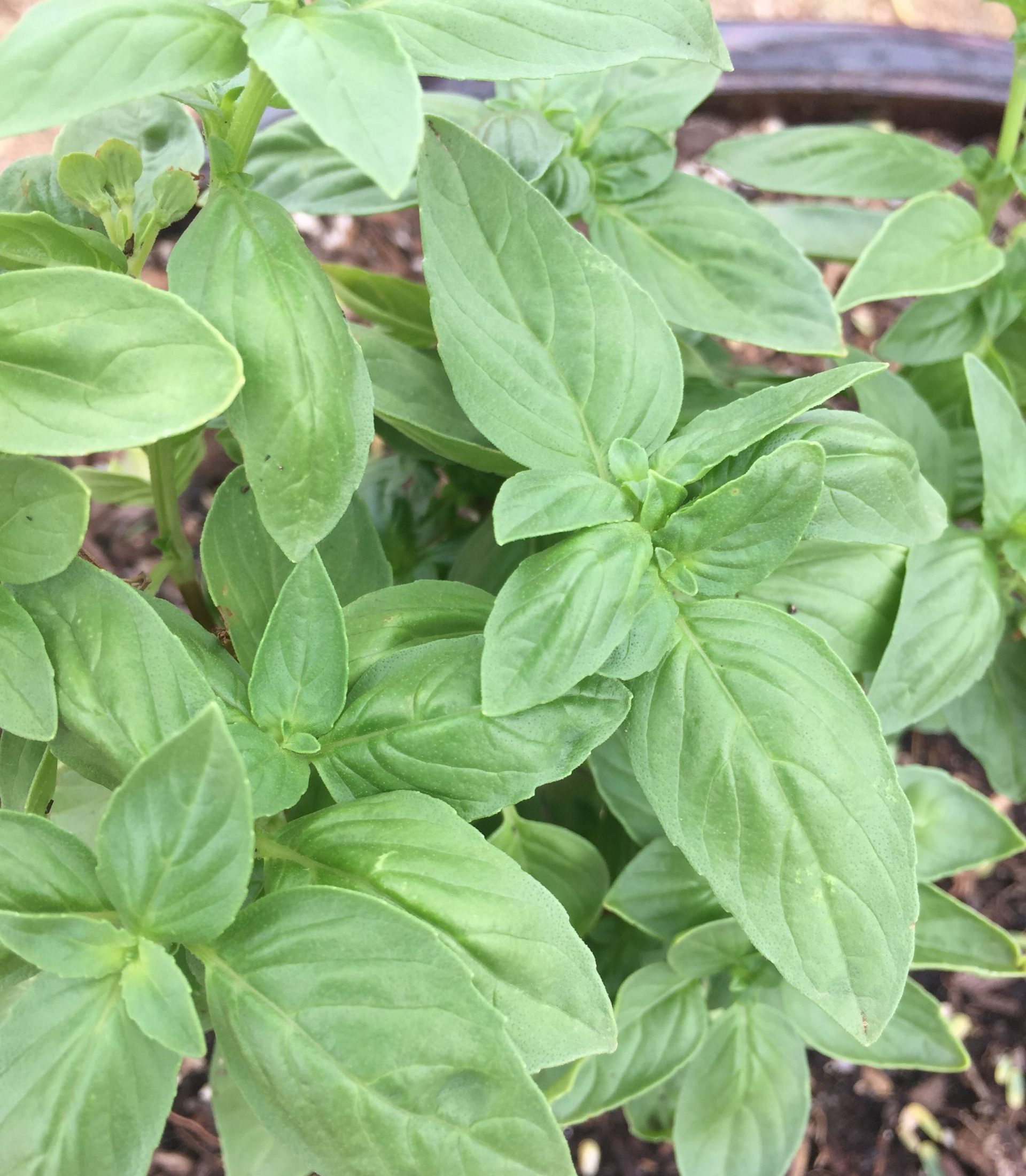Learn how to prune basil to ensure lush, vigorous growth. Pruning basil correctly will help the plant to grow bushy and longer. Basil grows easily. Taking steps to trim it properly and timely will enable you to use the leaves, grow more leaves, and propagate new basil plants.
Why You Should Prune Basil
There are a few good reasons for trimming basil, including harvesting, spurring growth, growing new plants, and prohibiting it from going to seed. Pruning helps extend the utility of the plant. Here are the highlights.
Pruning to Harvest Basil
The most apparent reason for pruning basil is to harvest it to eat fresh leaves. Even if you’re picking a few leaves quickly for cooking or to add to a salad, follow proper pruning protocol. You can also harvest a lot and dry it.
Pruning the right way so you avoid damaging the plant. You’ll also encourage future growth. Learn how to harvest basil.
Pruning to Grow Bigger Basil Plants
It might seem like pruning basil is a negative thing that will leave you with a smaller plant than when you started. In fact, research shows that trimming plants allows them to thrive. Why?
Every offshoot on a plant impacts its growth. For example, the plant’s primary shoot can impede the development of lower shoots if you fail to trim it.
For a shoot tip to remain in an active growth phase, it must export a particular plant hormone, auxin, to the primary stem. If the primary shoot already has too much auxin, the offshoots can’t transfer their auxin to it.
The various offshoots of the plant thus all essentially compete with each other. By trimming certain offshoots, you are giving others the chance to thrive, allowing for more even, bushy, dense growth.
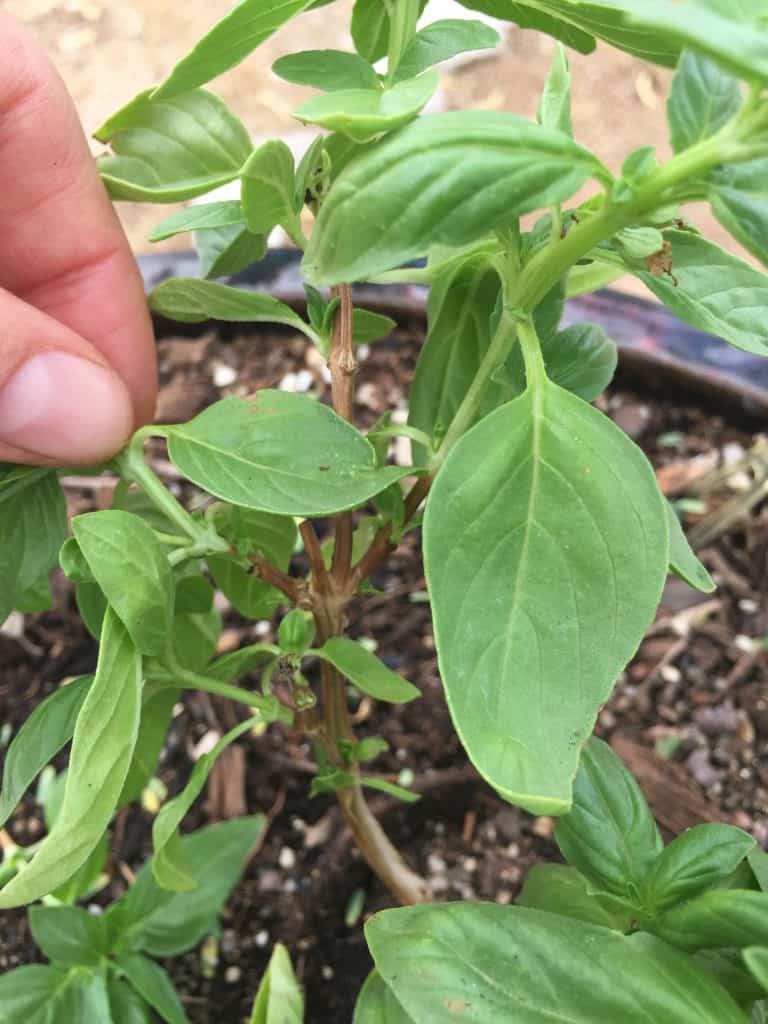
Trimming Basil to Grow New Plants
Pruning also give you the advantage of growing more plants. When growing basil plants, you can use the stems to root and propagate new basil. It’s so easy.
- Find the main stem of your basil plant
- From the stem, look for offshoots that branch out
- Choose sturdy ones with several leaves
- Cut or snip at the base of the stem
- Remove the lower leaves, keeping the top 2 – 3 basil leaves
- Put the basil cutting cut side down in a glass of water
- Place in a sunny spot on your kitchen counter to root
- Change out water every 1 – 2 days
- When roots are 3 inches long, transplant in soil outdoors, hardening off as needed
Basil Pruning So It Doesn’t Set Seed
Finally, it’s important to pinch off the flowers when you see them. Basil plants are annuals. It grows leaves, then flowers and goes to seed. After this time, it stops growing and eventually withers away and dies.
When a basil plant flowers, it will soon produce seeds. When this happens, leaves will stop growing. It’s essential to keep an eye on mature basil plants and snip the flowers as soon as possible.
You may want to allow the basil to set seed if it’s toward the end of the growing season and frost is approaching. You may also want to harvest basil seeds to regrow the following season. Be sure to harvest the leaves when you collect the seeds. The plant won’t continue to grow.
When You Should Prune Basil
Timing is essential when pruning basil. You can start pruning the plant when it’s about 6 – 8 inches in height. At this point, the young seedlings will likely consist of a single stem with three to four bunches of leaves.
These are true leaves. The first set of leaves that grow on basil plants are called seed leaves. The next round of leaves that grow are true leaves. These are the basil leaves you want to look for. Once they have three sets of these true leaves, you can prune.
When you’re trimming basil this early on, you can take a more aggressive approach. If you prune the main stem down to just above a set of side shoots, you may be able to get a double-stemmed basil plant. This will ultimately double the number of basil leaves you harvest.
After this initial snip, let a few weeks go by before trimming again. Once your plant is more mature, you can anticipate it requiring pruning every second week. This will help you reap the rewards of the benefits mentioned above.
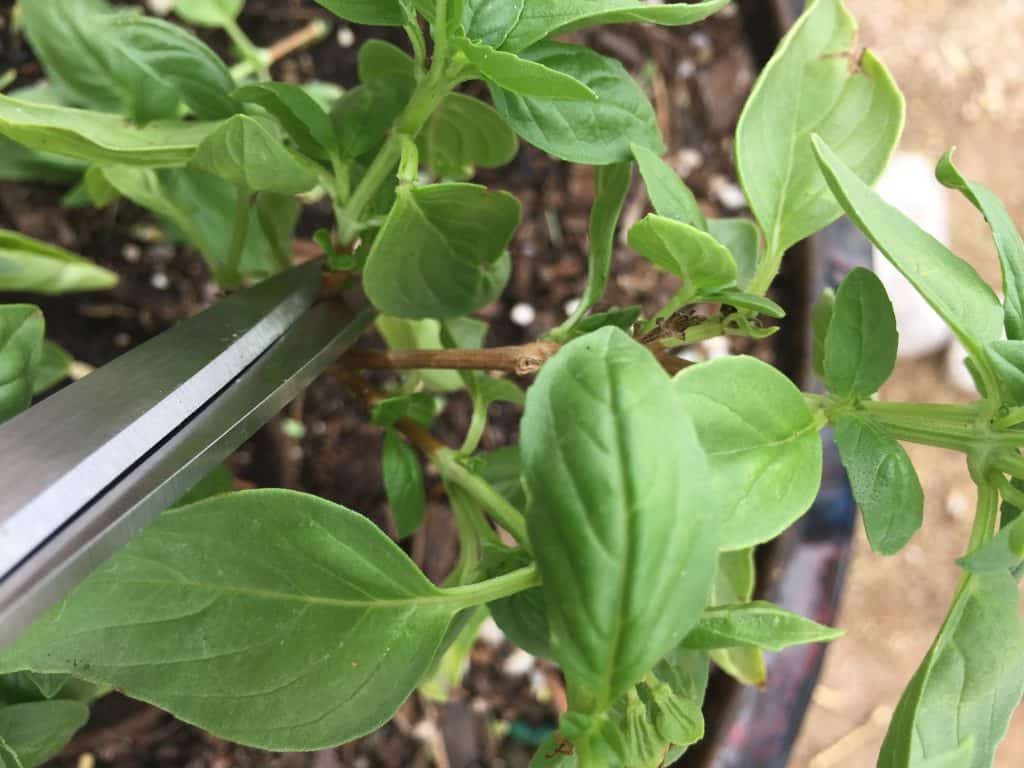
In general, basil grows reasonably quickly. You may find that you will have to trim more than every two weeks in the vibrant, growth-heavy summer months. For example, flowers may develop more quickly and require frequent cutting back in this season.
Keep cutting basil throughout the summer season.
What Tools You Need to Prune Basil
If you are gentle, you can snip basil leaves off with your fingers by pinching them off. It’s important to never snap basil stems off or pluck leaves vigorously.
This will not stimulate new growth in the way that proper pruning does. Instead, you need to snip the top section of each stem cleanly.
While not necessary, these gardening supplies will help:
- Small herb pruning shears or scissors
- Container for clippings
- Garden gloves if you want to keep your hands clean
Make sure your herb pruning shears are sufficiently sharp to ensure a clean cut. If they’re dull, they may tear the plant’s stem and cause damage that hinders the growth you want. You can use a file to sharpen shears. Alternatively, you can likely take them to your local hardware store for sharpening.
You can use a pair of sharpened gardening scissors instead of herb shears if you prefer.
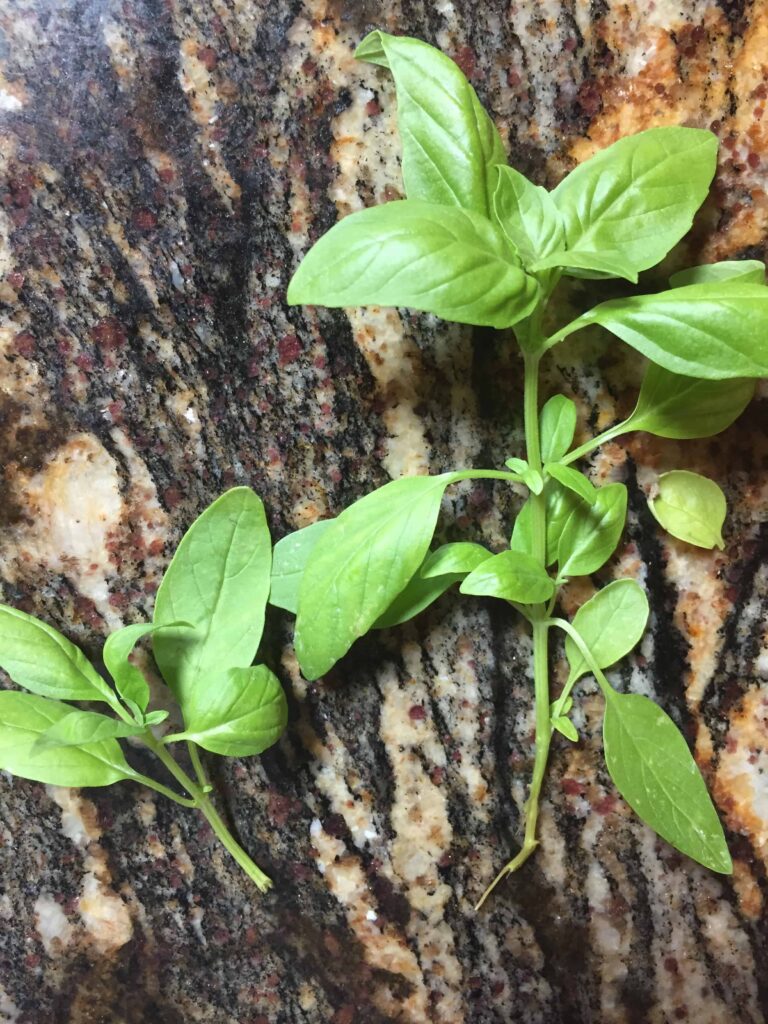
How to Prune Basil
Pruning basil correctly requires careful attention to detail. Follow these steps to do the job right.
Look for Sturdy Branches
Examine the basil plant, looking for a spot on the branch that has new growth. You should be able to see tiny leaves growing. You don’t want to cut off the tiny leaves. Instead, designate a point on the branch above where the little leaves are growing. This is where you’re going to make the snip.
Make the Cut (aka Snip It)
Hold the stem in one hand and the shears or scissors in the other hand. Gently make a snip at your designated spot. You should be able to prune in one clean snip. If this isn’t possible, your shears or scissors need sharpening.
Repeat this process, targeting any branches that have those small leaves growing on them. In a few weeks, those small leaves should develop and grow into brand new branches.
Pinch the Flowers Out
The process of removing flowers is a bit different. You can pinch the buds of the flowers off using your fingers. Hold the stem in one hand, and then use your thumb and forefinger to pinch the bud at the bottom and snip it off.
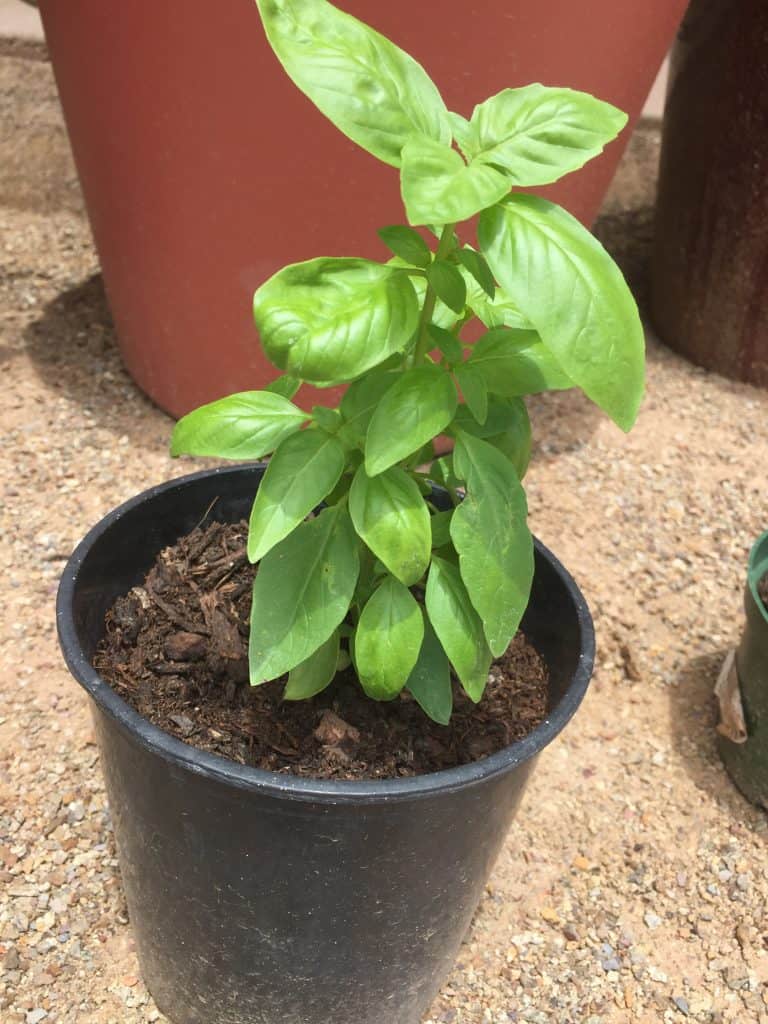
Use the Trimmings
What should you do with the basil clippings? You may use them in fresh cooking—or learn how to dry basil and preserve them for future recipes. Freezing is another option. Alternatively, if they aren’t exceptionally flavorful, you can compost them.
Pro tip: The tiny bits of basil you get from harvesting may be ideal for making into pesto. You can freeze it in ice cube trays. You’ll have to grind up the basil for pesto anyway so that these tiny pieces can be perfect for a tasty recipe. This applies to the flower buds, too!
Make a Note
Proper basil plant care involves watering and pruning. If you use nutritious soil, you shouldn’t need to add organic fertilizer. Being these are annual plants, you can replenish the soil each year.
If you tend to have trouble keeping track of your gardening tasks, make a note of every “haircut” you give your basil plants in your calendar. Setting a recurring reminder in your phone’s digital calendar system can be helpful. This way, you won’t forget when it’s time to trim.
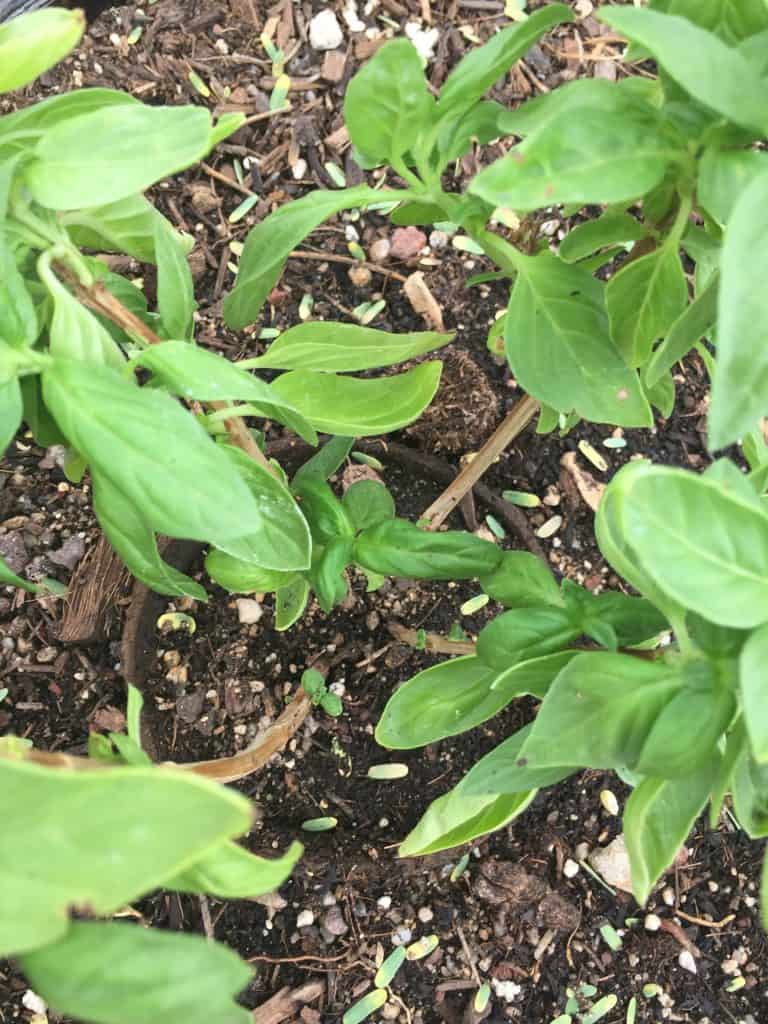
There are times when you may have to deviate from the two-week trimming schedule rule. For example, if you notice that the basil plant is growing more quickly in summertime or flowering, you may have to do an added trim.
Basil is an aromatic and flavorful herb that you can use in everything from salads to pasta sauces. It even has nutrition benefits due to an abundance of Vitamin K, Vitamin A, and Manganese, among other nutrients.
How to Prune Basil for Big Plants
Pruning basil correctly is easy. Beginner gardeners can do the job. You also don’t need complex supplies. All it takes is a steady hand and a bit of patience. It’s also easy to snip the leaves with small herb shears.
The process is the same whether you want to prune Thai basil, Lemon basil, Greek basil, Genovese basil, Cinnamon, etc. There are many types of basil.
The above guide explains how pruning helps basil plants and to how to prune basil along with the steps you’ll need. If you follow these tips, you should be able to cut basil in a way that boosts growth and yields more leaves on bushy plants.
This will make the short amount of time it takes cutting back basil worth it. Simply taking a few minutes to prune your plants every two weeks will yield more growth and leave you with more delicious basil herbs to flavor your food.
Proper basil pruning can also potentially save you money, as it will spare you the cost of purchasing additional basil plants due to low yields. You’ll be able to multiply your basil crop and expand your herb garden easily. It grows great in containers and in small spaces, indoors and outdoors. This makes it ideal herb to grow on balconies and on patios or in a small greenhouse.
Given the many advantages of trimming basil properly, there’s no reason not to put in the little bit of time and effort it takes. You will be rewarded with so many leaves, you’ll have to find lots of uses for them. Basil plants make great gifts for neighbors as do dried and crushed basil leaves in spice jars.

